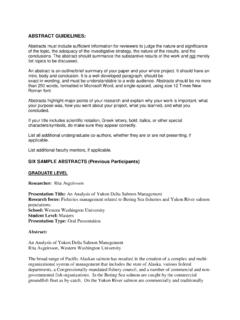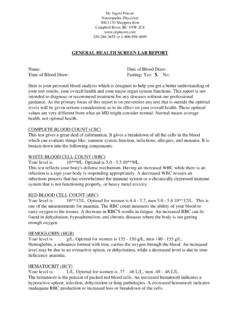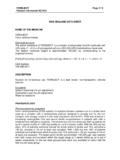Transcription of Approach to a high ferritinlevel: the hepatologist ...
1 Approach to a high ferritin level: the hepatologist s perspectiveAmer El-Sayed, day, LSGEMay 28, 2011 ferritin Major storage protein for iron Present in large amounts in macrophages and hepatocytes (storage) In erythroblasts (for metabolic purposes) Small concentrations in plasma (not transport protein like transferrin) reflects total iron body stores Most widely used surrogate for iron overload (highly sensitive in Hemochromatosis), low : etiology Increased ferritin synthesisAcquired or genetic conditions, with or without iron overload Increased ferritin releaseFrom damaged cells: steatosis, steatohepatitis, chronic viral hepatitis, liver necrosis, acute hepatitis, acute MI, splenic infarct Clue: clinical settingHYPERFERRITINEMIA: etiologyIron overload Primary: Hereditary hemochromatosis Hereditary aceruloplasminemia Secondary: Transfusion overload Excess dietary iron Porphyria cutanea tarda Cutaneous photosensitivity Hepatic iron overload Urinary and fecal porphyrinexcretion Ineffective erythropoeisis(sideroblastic anemia)Liver diseases / Acute inflammation NASH / NAFLD Viral hepatitis Familial hyperferritinemia-Cataract syndromeAlcohol excess Regular consumption: disruption of normal iron metabolism Excess deposition of iron in liver in 1/3 of alcoholic patients Process: unclear.
2 Both ferritin + transferrin PC, J Hepatol, Feb. 2011 HYPERFERRITINEMIA > 90 % of outpatients: Chronic alcohol intake Inflammation ( CRP) Cell necrosis ( TA- CK) Malignancy ( ESR, imaging) NAFLD and/or Metabolic syndrome ( HTN, BMI, Chol, TGL, Glucose) Often measured if: Persistent elevation despite treatment investigate fatigue, possible liver disease, anemia or concentration of ferritin Variable (lab, personal) Large multi-ethnic multi-racial screening study of iron overload north americans patients:> 300 g/L in males> 200 g/L in females Mean SF - % of patients with high SF Higher in blacks, asians, pacific islanders vs. whites Transferrin saturation: TS > 50 % in males, > 45 % in females TS higher in asians, lower in african americans Elevated SF and TS are not always indicators of diseaseAdams PC, NEJM 2005:352:1769-1778 Never test ferritin /TS in acutely ill patients:- ferritin misleadingly high- TS conversely low, may mask iron overloadUse of Transferrin saturation to interpret serum ferritin Clinicians rely on TS to interpret elevated ferritin levels.
3 Iron overload Iron deficiency Subnormal iron mobilization for erythropoeisis Reliability not 100% accurate Large population screening cohort significant biological variability in serum TSUse of Transferrin saturation to interpret serum ferritin 64230 patients Non-fasting TS >45 % (males) and >50% (females)Se 75% Sp 95%in detection of C282Y homozygotes(fasting failed to increase sensitivity) reliability and specificity of TS in clarifying significance of high ferritin levels Acute infection / Menses / recent blood donation may decrease TS temporarily in patients with hepatic iron PC, Am J Med 2007;120:e1-e7 Relationship between TS and liver iron concentrations TS predicts hepatic iron overload better in C282Y homozygotes.
4 Some patients with normal TS and high ferritin may have hepatic iron overload (proven by histology)Beaton M, Liver Int2011;31 FerritinHigh TSNormal TSIron OverloadMRI: assess liver concentration, Fe distribution (spleen, pancreas)Liver biopsy: steatosis, steatohepatitis, fibrosisNo Iron overloadQuestion?High ferritin , normal TSUseful to measure AST, ALThepatocyte necrosisiron overloadU/S liverfatty liver, steatohepatitisAlcohol consumptionhistory, GGT HBsAg, HCV Ab ferritin without Fe overloadCommon causesNormal TS, no iron overloadLiver diseasesNASHV iral hepatitisChronic inflammatory conditionsRheumatoid arthritisIBDB acterial infectionsMalignancies (esp. hematologic)ThyrotoxicosisExcessive Alcohol intakeNormal TS, no iron overloadHEREDITARY HYPERFERRITINEMIA-CATARACT SYNDROME Up-regulation of L- ferritin Constantly elevated ferritin levels No iron overload L- ferritin deposition in ocular lens causing bilateral cataract at early ageHetet G, Blood 2003;102:1904-1910 DYSMETABOLIC SYNDROME Metabolic syndrome: Obesity, Dyslipidemia Diabetes, Hypertension Liver biopsy: Iron deposition in Kupfer cells (peri-portal-hepatocytic in HFE-HC) / steatosis No iron overloadNormal TS, hepatic iron overloadACERULOPLASMINEMIA Rare genetic syndrome Mutation in gene that encodes for ceruloplasmin Retinal abnormalities Neurologic manifestations (dementia, cerebellar ataxia) Vs.
5 Wilson s: Absence of ceruloplasmin in serum Absence of excess copper storage in liver Absence of excess UcopperFERROPORTIN DISEASE Mutation of SLC40A1 encoding for ferroportin Rare, autosomal dominant Significant liver iron depositionLiver biopsy Well established tool for evaluation of iron overload + concomittant liver diseases In normal TS patients, indication to biopsy: High SF and presence of confounding factors Exclude iron overload Stage, diagnose liver disease Not routinely recommended to assess Fe overload if SF < 1000 g/LLiver biopsy in confirmed hepatic overload Limited indication With availability of HFE-genotyping: Homozygous C282Y + high iron body stores enough for diagnosis of HFE-HC Histology only to grade degree of fibrosis In C282Y homozygous patients, if: Normal liver/ ferritin < 1000 g/L/normal AST NPV ~ 95% for significant liver fibrosis If 1, 2 or all criteria not met High risk of fibrosisGuyader et al, Gastroenterol 1998;115 regression: role for liver biopsy 36 C282Y homozygous patients Severe fibrosis: bridging fibrosis to cirrhosis Regression noted in 69% of F3 vs.
6 35% of F4 Falize J, Hepatology 2006;44:472-477 Improvement / resolution of esophageal varicesreported with phlebotomyFrancanzani AL, Hepatology 1995;22:1127-1131initial F3initial F469%35%Fibrosis regressionIron overload disordersHigh ferritin , high TSIron metabolism Fe reutilized in closed circuit Central role of liver through hepcidin production Hepcidin: major regulator of intestinal iron and iron delivery to plasma Hepcidin controls iron transport into dodenum and iron export in macrophages Hepcidin degrades ferroportin (transport) blocks Fe release from cells to plasmaIronInflammation HypoxiaAlcoholObesityCirculatory hepcidinmacrophageduodenumPathophysiolog y of iron overload disorders Hepcidin deficiency: central pathogenic factor in HC Unrestricted flow of iron into the plasma iron pool Some taken up by bone marrow, some stored in hepatocytesas ferritinGenetic Iron overload disordersHEMOCHROMATOTIC Normal erythropoeisis Parenchymal Fe distribution related to hepcidin dysfunctionHFE-HC (type 1)JUVENILE HC (type 2)Transferrin Rec 2 TFR2 (type 3)
7 Type B ferroportin diseaseNON-HEMOCHROMATOTIC Type A ferroportin disease Hereditary aceruloplasminemia Hereditary atransferrinemiaAcquired iron overload disorders Chronic excessive iron supply Hematologic disorders Thalassemia Myelodysplastic syndrome Sickle cell anemia Chronic liver diseases Destruction of hepatocytes Decreased hepcidinRecommendations for Genetic testingEASL guidelines J. hepatol 2010;53:3-22 General population Unexplained chronic liver disease with high TS Pts with Porphyria CT, well-defined chondrocalcinosis, HCC Type 1 DM Suspected iron overload: fasting SF and TS HFE genotyping only if TS elevated (at least once) Testing for C282Y and H63D polymorphism Consider liver biopsy if ferritin > 1000 g/LFerritin: a prognostic marker SF: predictor of risk of cirrhosis Multiples studies: Cirrhosis rarely occurs if ferritin < 1000 g/L Allows estimation of incidence of cirrhosis in C282Y homozygous patients Liver Bx in 350/672 pts (SF > 500 g/L, hepatomegaly, elevated TA) Cirrhosis.
8 Of males, of females (all ferritin > 1000 g/L) ROC curve ferritin 1653 g/L Se 90%, Sp 92 % for predicting cirrhosisGuyader D, Gastroenterol 1998; Morrison ED, Arch Int Med 2003, Powell M, Arch Int Med 2006 ferritin : monitor of treatment SF sufficient to monitor iron depletion Endpoint of therapeutic phlebotomy (standard of practice) SF < 20-50 g/L, TS < 30 % (within 1-2 yrs) Maintenance (prevent re-accumulation) Keep SF between 50-100 g/L Other Approach Resume phlebotomy when SF reaches upper limit of normalFerritin: predictor of steatosis in chronic liver diseases 124 patients with hyperferritinemia Steatosis confirmed by U/S (present or absent) Histology in 53 pts only 43% hep C, 46% NAFLD/NASH, 11% AFLD ferritin .
9 Independent predictor of steatosis (in non-obese non alcoholic patients) High SF associated with more advanced disease (low platelets, portal hypertension)Radicheva M. Trakia J Sci 2010 ferritin and OLT Hypothesis: elevated SF important predictor of mortality in patients awaiting OLT, independently of MELD Retrospective analysis 191 patients with cirrhosis 2000-2006 Walker N. Hepatology 2010-SF important and independent factor in predicting 180 d and 1 year mortality -Identified both in study and validation cohort-Higher frequency of liver related complications during follow-up in patients with high SF (necro-inflammatory activity)AUC for MELD vs. MELD+SFFerritin in evaluation of anemia by colonoscopyConclusion: ferritin value of 100 g/L should be used as cut-off for selecting patients with anemia for colonoscopyMandeep S.
10 Am J Gastro 2007:102:82-88







